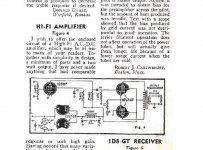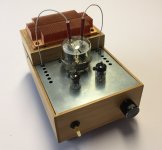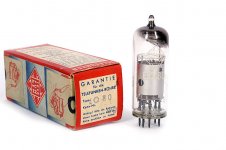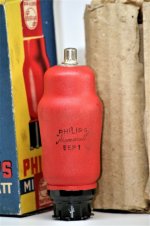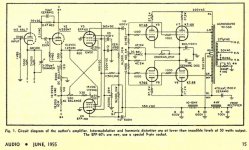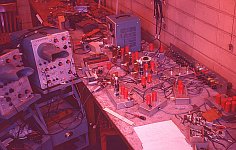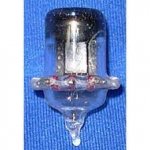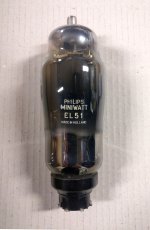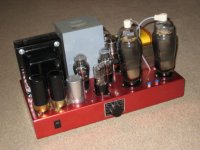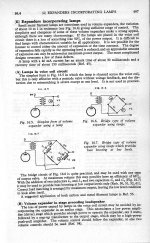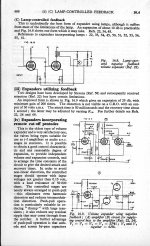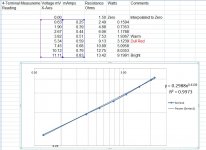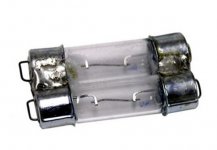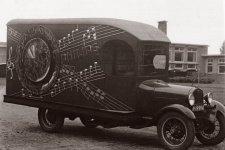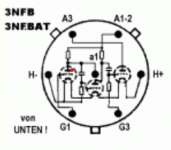This is the beginning of a project to build an amp/radio, in 50s style, I want to have some really wacky tubes.
Do you want something cheap and easily available? The 832a tube glows more than most audio tubes and a 250v power supply is enough for the low distortion triode mode. It surely draws attention. 829a is the big brother with higher power. I've built a 832a single ended amplifier mostly for the look. This tube becomes hot, the metal plate in the picture can't be touched despite the concealed aluminium heatsink at the bottom of the amplifier. There are many tubes that have a unconventional look, but I believe that price wise the 832a is a winner. It is also called GU32 , FU32 and qqe04/20 .
Attachments
The EEP1 secondary emission tube as preamplifier/phase-splitter (introduced 1947). Not HiFi though.
The EQ80 (with seven grids) as limiter/detector for FM (introduced 1950). Worked well but didn't become popular.
The EQ80 (with seven grids) as limiter/detector for FM (introduced 1950). Worked well but didn't become popular.
Attachments
I believe that EQ80 is the only tube with more than 6 grids ever manufactured. No wonder that never became popular, it surely was a nightmare to build and the price was at least two times higher than any tube radio frequency changer. And yet the manufacturer application note lists a circuit to use it as audio frequency amplifier, basically defeating the purpose of most of the grids. I have a box of this weird tubes, and maybe I will test this schematic someday.
EFP60 Secondary Emission Tube in HIFI Amp
The EEP1 secondary emission tube as preamplifier/phase-splitter (introduced 1947). Not HiFi though.
Here is one example using a pair of EFP60's. They also work very well as a pulse generator with nS rise times.
The EEP1 secondary emission tube as preamplifier/phase-splitter (introduced 1947). Not HiFi though.
Here is one example using a pair of EFP60's. They also work very well as a pulse generator with nS rise times.
Attachments
The EQ80 as limiter/detector can drive a sensitive enough power tube so no further preamplification is needed at FM. I think Philips also published data for the EQ80 as an audio amplifier in the hope that it would get used in AM/FM radios as the preamplifier after the AM detector. Else it would have no use at AM.
The EQ80 was a bit expensive but it does both the limiting and detecting, which most of the time takes two tubes. Attached a price list from around 1955.
The EQ80 was a bit expensive but it does both the limiting and detecting, which most of the time takes two tubes. Attached a price list from around 1955.
Attachments
Last edited:
The 717a "Door Knob" tube. Electrically the same as 6AK5, so easy to implement.
717A @ The Valve Museum
717A @ The Valve Museum
My vote for the front tubes 2C22 with two top caps:
https://frank.pocnet.net/images/RCA/2/2C22_RCA_049.jpg
or else, if you could find the sockets, an acorn tube like 955:
https://frank.pocnet.net/images/RCA/2/2C22_RCA_049.jpg
or else, if you could find the sockets, an acorn tube like 955:
Attachments
The EL51 from 1940. In push-pull with Va = Vg2 = 750 V a light bulb of 68 Watt should be connected in series with the screen grids to prevent them from overloading.
The amplifier on the picture was made by "Corné", a Dutch hobbyist. In his amplifier the EL51's are triode connected with B+ = 650 V.
The amplifier on the picture was made by "Corné", a Dutch hobbyist. In his amplifier the EL51's are triode connected with B+ = 650 V.
Attachments
Do you want something cheap and easily available? The 832a tube glows more than most audio tubes and a 250v power supply is enough for the low distortion triode mode. It surely draws attention. 829a is the big brother with higher power. I've built a 832a single ended amplifier mostly for the look. This tube becomes hot, the metal plate in the picture can't be touched despite the concealed aluminium heatsink at the bottom of the amplifier. There are many tubes that have a unconventional look, but I believe that price wise the 832a is a winner. It is also called GU32 , FU32 and qqe04/20 .
Can't run in PP triode mode tho, the screens are tied together.🙂
The EL51 from 1940. In push-pull with Va = Vg2 = 750 V a light bulb of 68 Watt should be connected in series with the screen grids to prevent them from overloading.
The world’s first light bulb limiter?
And a “140 watt” amplifier application back in 1940, when a speaker maybe could handle 10?
Make all the triode signal amplification stages out of 6E5s - even if the cat eye part never deflects...
Light Bulb Limiters
Here are some examples.
The PX Bulbs are used in some music instrument circuits for their limiting effect.🙂
Here are some examples.
The PX Bulbs are used in some music instrument circuits for their limiting effect.🙂
Attachments
Can't run in PP triode mode tho, the screens are tied together.🙂
Just use two per channel.
And a “140 watt” amplifier application back in 1940, when a speaker maybe could handle 10?
They made quite large speakersystems for cinema and other bigger venues at the time. An example: Euronor-hogtalare
In 1929 Philips was driving around in this van called "The voice of the giant" for promotion purposes. It was powered by a 60 Watt amplifier with a MB2/200 power triode (200 Watt anode dissipation).
Attachments
Last edited:
Make all the triode signal amplification stages out of 6E5s - even if the cat eye part never deflects...
Or use the EFM1, a combined AF vari-mu pentode and tuning indicator. The tuning indicator is controlled by the screen grid of the pentode section.
EFM1 @ The Valve Museum
- Home
- Amplifiers
- Tubes / Valves
- What are some of the wackiest tubes?
